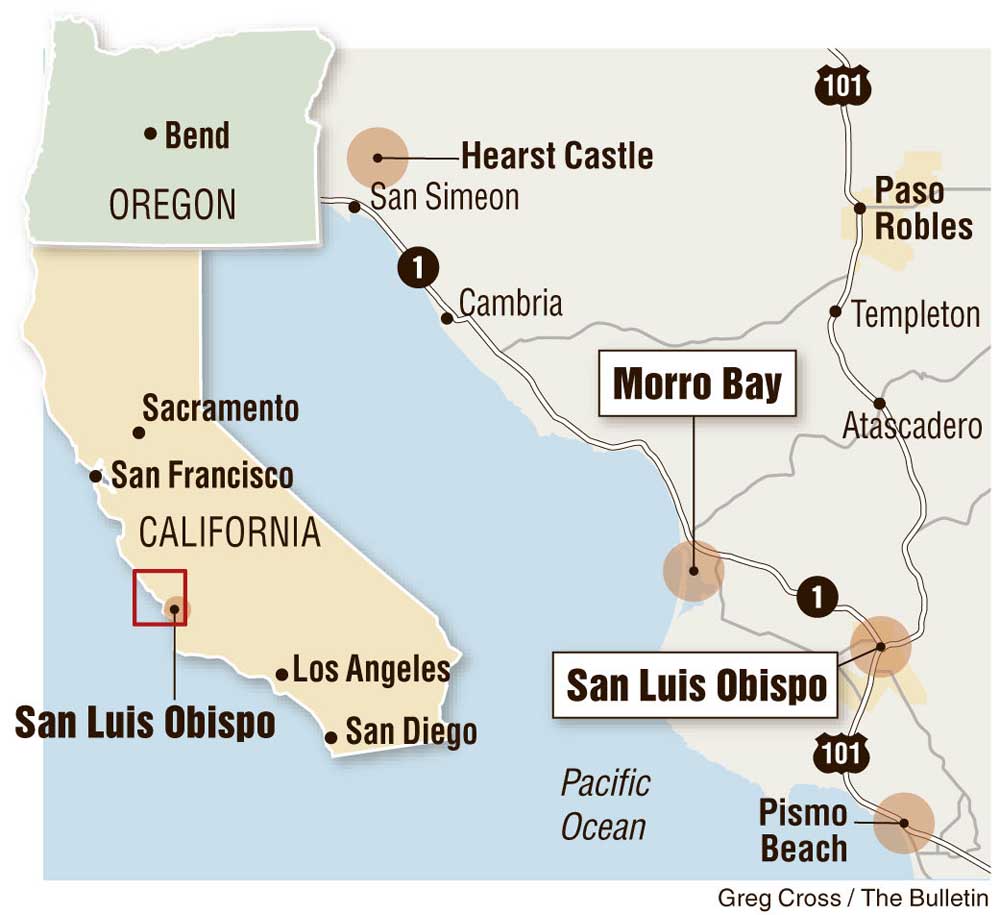Travel: California’s pearl of an oyster town
Published 12:00 am Sunday, May 8, 2016

- Travel: California’s pearl of an oyster town
MORRO BAY, Calif. — A typical visitor to the town of Morro Bay, at the heart of California’s Central Coast region, might stop on the Embarcadero and simply admire the view.
It is unforgettable, to be sure. A huge, domelike rock guards the mouth of the bay, where resident sea otters dive into the near-shore kelp beds to emerge with tasty shellfish treats. Brown pelicans soar through frequent fogs and follow the fishing vessels that dock in the harbor: Morro Bay is a classic Pacific coast fishing town.
Trending
Tourists are kept entertained by whale-watching cruises, kayak rentals, art galleries, gift shops, a skateboard museum and seafood restaurants. Adjacent state parks offer spectacular seascapes and tide pooling.
But I was not a typical visitor. Even as spring storms threatened, I spent my afternoon on a flat-bottomed oyster boat, puttering out to a tiny platform surrounded by an aquaculture farm in the shallows of the 4-mile-long bay.
Neal Maloney, who founded the Morro Bay Oyster Company in 2008, had invited me to come along for the ride: A University of Oregon marine biology graduate, Maloney was proud to share his life’s work. After all, his company is the only one that harvests Pacific Gold oysters by hand from the waters of this pristine bay.
We weren’t alone. My friend Dave Buckingham, Morro Bay’s city manager, had arranged the visit. He brought his wife, Kendra, and four of their children on a home-schooling field trip. And Maloney provided a lesson far more stimulating than any I ever received from a high school science teacher.
Orientation
A city of 10,000, Morro Bay is the largest of several communities along the San Luis Obispo County coastline, 200 miles northwest of Los Angeles and 235 south of San Francisco.
Trending
Unlike Pismo Beach, a surfers’ paradise with a quarter-mile-long pier, or Cambria and San Simeon, which serve as bustling gateways to the Hearst Castle historic site, Morro Bay strikes a balance between a working harbor town and a tourist destination.
Not far inland are two more small cities — the old Spanish mission town of San Luis Obispo, home of California Polytechnic University, and the booming wine center of Paso Robles. Each is worth exploration in its own right.
But I focused my visit primarily on Morro Bay. Once a Chumash Indian settlement, the location was noted by Spanish explorers in 1769. The sheltered harbor became a shipping harbor for local cattle ranches before the town itself was founded in 1870, 12 miles northwest of San Luis Obispo.
Its most distinct feature is Morro Rock, a 576-foot-high volcanic plug connected to the mainland by a breakwater and causeway from Coleman Park. Climbing in this peregrine falcon reserve is forbidden except by permit.
While Main Street, several blocks inland from the waterfront, has a charming “uptown” area of small cafes and shops, most visitor activity is centered along the Embarcadero, which extends for more than a mile. There are numerous restaurants and pubs, as well as an aquarium and several bay-cruise tour operators.
It was from the Embarcadero that I began and concluded my oyster adventure. The Morro Bay Oyster Company operates from a newly expanded (but still small) building beside the U.S. Coast Guard at the north end of the waterfront. Maloney proudly described his new water-filtration system, then introduced us to the “seed” oysters which, when mature, may grow to the size of a human hand. I reached into a bucket and palmed several hundred of the tiny mollusks, each smaller than a pencil lead.
Oyster farming
We drove to the small marina at Morro Bay State Park, a couple of miles south, to board our scow. The water in the southern section of the bay is so shallow as to discourage deep-drafted boats from intruding, even if its seabed were not rife with prolific eel grass, but our craft was specially built for the task.
The brackish estuary is fed by two freshwater streams, Chorro and Los Osos creeks, that flow from volcanic aquifers to assure the pristine quality of its water — much like Netarts Bay and Willapa Bay, Washington.
Oyster farming began here more than 100 years ago. For many years, Morro Bay was farmed by the large Tomales Bay Oyster Company in California’s Marin County. In fact, the “Point Reyes oysters” marketed at San Francisco’s famous Ferry Building were mostly his own, Maloney said.
After completing specialized studies in business and aquaculture, Maloney said, he was hired to work for the Tomales Bay company in 2004. Four years later, when the previous owner retired, he launched his own business and formally branded Morro Bay oysters “Pacific Golds.”
We had seen them in their infancy, submerged for six to eight months in the waters of the nursery. Now, we headed out to see where they grew to adulthood. The young shellfish, Maloney said, are transferred to mesh bags fixed to long, floating lines that rise and fall with the tides. Nutritious plankton flow freely through the mesh, where over a period of 12 to 18 months the oysters grow rapidly, forming a deep, layered shell that enables them to thrive in the strong, twice-daily tides.
Strong winds and spring rains bring changes in water temperature, salinity and nutrients, he said, but the hardy Pacific Gold oyster adapts, developing a robust, briny flavor with a distinct melon finish. They are sold to local restaurants, at farmers markets, directly off the barge and, yes, at San Francisco’s Ferry Building, Maloney said.
Time to eat
Our group put the taste description to the test almost immediately. We disembarked from our scow onto the barge, where three employees clad in orange raingear hand-sorted each and every oyster from surrounding lines, separating them by size and bagging them in lots of 50. Our host swooped in and began shucking and offering straight-from-the-bay oysters — plain, or with a dash of hot sauce — to each of us.
For the sake of the home-schoolers, he also played marine biology professor, carefully describing the anatomy of Crassostrea gigas, the Pacific oyster species, as he separated muscle from shell with his shucking blade.
We departed the barge with a full bag of 50 oysters, returned to shore and headed back to the Embarcadero, where chef Leonard Gentieu, owner of the Papagallo II luxury yacht, awaited our arrival.
The Papagallo II offers small-group charters, in particular special-occasion dinner parties. Although we never left our mooring, thanks to Buckingham’s friendship with the chef we enjoyed many of the fruits of such a cruise. Gentieu and Maloney teamed to cook all 50 oysters in several different styles, and in company with local wines from the Paso Robles viticultural area, they made an outstanding meal.
Paso Robles
About 32,000 people live in Paso Robles, a former ranching and orchard town on the Salinas River 28 miles northeast of Morro Bay. Wines have been made commercially here since the late 19th century, but it’s really only been since the 1960s and ’70s that the industry has come to dominate the economy.
Today more than 250 wineries, producing at least 25 different varietals, are spread across the rolling hills in all directions from Paso Robles. A majority, it would seem, are to the southwest, along California State Highway 46 to Cambria. My tongue danced after tastings of chardonnay, viognier, malbec, cabernet sauvignon and zinfandel at the Castoro, Niner, J Dusi and Barton Family wineries.
I was most impressed, however, by the Halter Ranch, several miles west of town via Adelaida Road. A beautiful gravity-flow winery stands on a hillside within view of the ranch’s original 1885 farmhouse and the majestic Ancestor Tree, a giant California live oak of indeterminate age. Of the property’s 900 acres, 280 are planted in grapes, including cabernet sauvignon, syrah and Grenache blanc.
The city of Paso Robles is built around a handsome, two-square-block city park that is presently undergoing restoration work. On its east side is the historic Paso Robles Inn, built around a mineral spring that has been popular since the 19th century. At the southwest corner of the square is the community’s best restaurant, Artisan, offering a choice between gourmet small plates and substantial entrees.
San Luis Obispo
The hub of the region, however, is San Luis Obispo, a city of about 50,000 that dates its history from 1772. That was when the famed Franciscan monk, Father Junípero Serra, established the mission San Luis Obispo del Tolosa, dedicating it to St. Louis, a 13th-century bishop of Toulouse, France.
Today the mission sits in the center of downtown, fronted by a broad plaza of sculptures and fountains. Behind is a colorful all-seasons garden, and between, an extended museum that documents early Central Coast history. Two masses are celebrated each day in the sanctuary.
San Luis Obispo sits about 12 miles inland (southeast) of Morro Bay and 28 miles south of Paso Robles on U.S. Highway 101. It’s a good central point for exploring all of its namesake county, from Pismo Beach (10 miles southwest) to Hearst Castle (38 miles northwest).
Locals refer to their city simply as “SLO,” pronounced (you’ve got it) “slow.” And it’s not wrong to make a comparison to the pace of life. Cal Poly SLO is just out of town to the northwest; its agricultural center includes a full-time working dairy that supplies local markets. The SLO Botanical Garden is one of many green swaths that attract lazy-day strollers or active hikers alike.
Another SLO landmark is the Madonna Inn, renowned for its 109 theme-based rooms (think actor Steve Martin’s “L.A. Story”) with everything from a Safari Room to a Caveman Chamber. The Old Mill Room has its own waterfall, which gratefully is not associated with the waterfall urinal in the men’s restroom off the dining room. (Even women may want to peek in to see that.) Horses continue to graze in the white-fenced fields surrounding the resort.
Of several outstanding restaurants in downtown SLO, I was especially delighted with the Foremost Wine Company and Novo. Foremost indeed serves wine, but chef Julie Simon’s creative and extensive menu is every bit the match, with dishes like miso-glazed black cod and grilled lamb sirloin. Novo, meanwhile, has a tiered outdoor seating area that overlooks the pretty creek winding through downtown.
Yes, both offered “SLO food.” But it was a different kind of slow than I discovered on the oyster platform in the heart of Morro Bay. I’m glad to have had the opportunity to enjoy both.
— Reporter: janderson@bendbulletin.com








